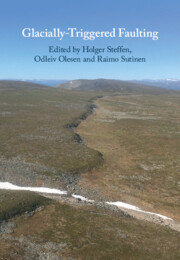Book contents
- Glacially-Triggered Faulting
- Glacially-Triggered Faulting
- Copyright page
- Contents
- Figures
- Tables
- Contributors
- Preface
- Part I Introduction
- Part II Methods and Techniques for Fault Identification and Dating
- Part III Glacially Triggered Faulting in the Fennoscandian Shield
- 10 Seismicity and Sources of Stress in Fennoscandia
- 11 Postglacial Faulting in Norway
- 12 Glacially Induced Faults in Sweden
- 13 Glacially Induced Faults in Finland
- 14 Lateglacial and Postglacial Faulting in the Russian Part of the Fennoscandian Shield
- Part IV Glacially Triggered Faulting at the Edge and in the Periphery of the Fennoscandian Shield
- Part V Glacially Triggered Faulting Outside Europe
- Part VI Modelling of Glacially Induced Faults and Stress
- Part VII Outlook
- Index
- References
10 - Seismicity and Sources of Stress in Fennoscandia
from Part III - Glacially Triggered Faulting in the Fennoscandian Shield
Published online by Cambridge University Press: 02 December 2021
- Glacially-Triggered Faulting
- Glacially-Triggered Faulting
- Copyright page
- Contents
- Figures
- Tables
- Contributors
- Preface
- Part I Introduction
- Part II Methods and Techniques for Fault Identification and Dating
- Part III Glacially Triggered Faulting in the Fennoscandian Shield
- 10 Seismicity and Sources of Stress in Fennoscandia
- 11 Postglacial Faulting in Norway
- 12 Glacially Induced Faults in Sweden
- 13 Glacially Induced Faults in Finland
- 14 Lateglacial and Postglacial Faulting in the Russian Part of the Fennoscandian Shield
- Part IV Glacially Triggered Faulting at the Edge and in the Periphery of the Fennoscandian Shield
- Part V Glacially Triggered Faulting Outside Europe
- Part VI Modelling of Glacially Induced Faults and Stress
- Part VII Outlook
- Index
- References
Summary
This chapter investigates the Fennoscandian uplift area since the latest Ice Age and addresses the question if glacial isostatic adjustment may influence current seismicity. The region is in an intraplate area, with stresses caused by the lithospheric relative plate motions. Discussions on whether uplift and plate tectonics are the only causes of stress have been going on for many years in the scientific community.
This review considers the improved sensitivity of the seismograph networks, and at the same time attempts to omit man-made explosions and mining events in the pattern, to present the best possible earthquake pattern. Stress orientations and their connection to the uplift pattern and known tectonics are evaluated. Besides plate motion and uplift, one finds that some regions are affected stress-wise by differences in geographical sediment loading as well as by topography variations. The stress release in the present-day earthquakes shows a pattern that deviates from that of the time right after the Ice Age. This chapter treats the stress pattern generalized for Fennoscandia and guides the interested reader to more details in the national chapters.
Keywords
- Type
- Chapter
- Information
- Glacially-Triggered Faulting , pp. 177 - 197Publisher: Cambridge University PressPrint publication year: 2021
References
- 2
- Cited by



